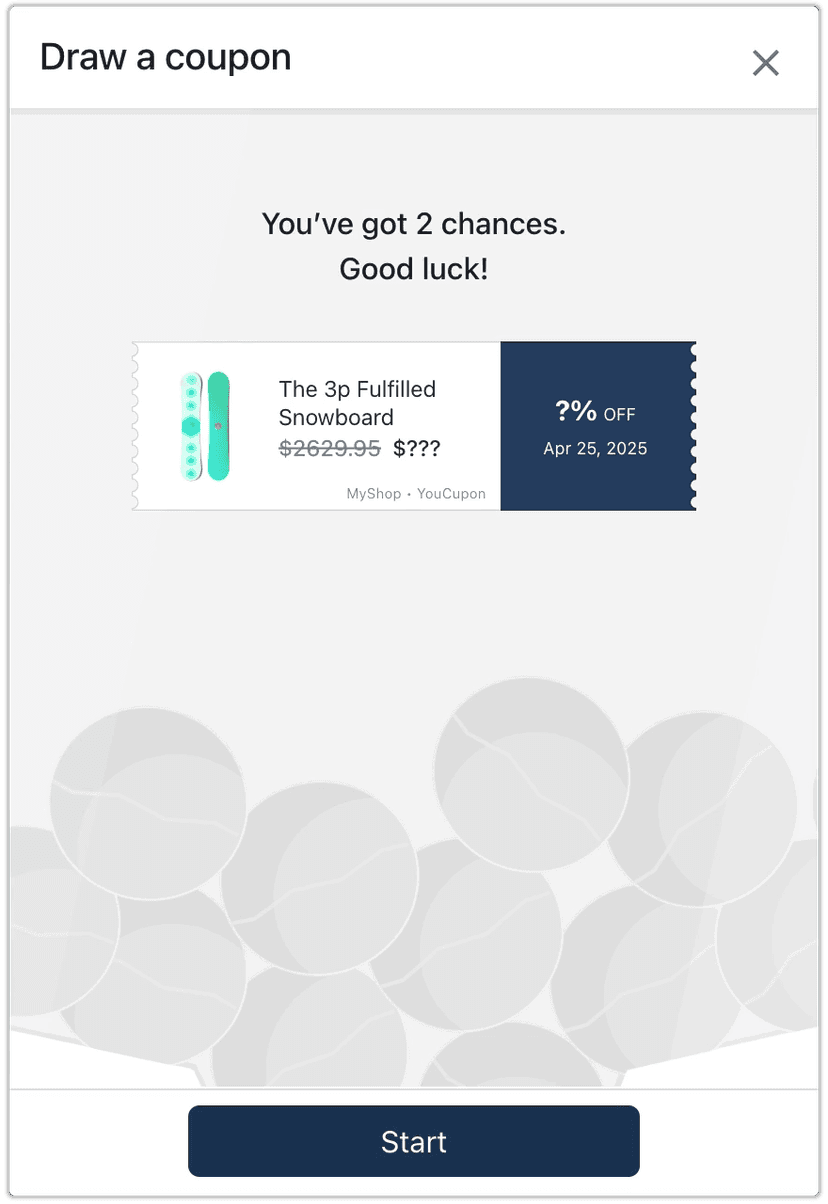Coupon Games
This section provides a detailed explanation of how coupon games work and explores the psychological principles behind their design. By understanding these aspects, you can effectively customize coupon games to boost user engagement and drive your business success.
If this is your first time using YouCupon, make sure to read the Quick Start guide and follow its instructions for a seamless setup.
Game Flow
Once your coupons are set up, customers can start playing the coupon game by clicking the "Draw a Coupon" button. This button appears on the product or checkout pages, inviting users to try their luck at winning a discount.
Here’s what they’ll experience in the game:
Entering the Game
Your customers will first see a target coupon to win, which we call the winning coupon, that can be applied to the product displayed on the page. The discount amount is initially hidden to spark curiosity. Along with the coupon, they will also see the number of chances they have.

The number of chances can be configured in coupon settings during setup your coupon.
Coupon Challenge
Your customers will be given multiple chances to draw the winning coupon. In each round, they will be asked to match objects, which are typically products from your shop.

If your shop doesn’t have enough products, the game may include some dummy objects to ensure diversity.
If you have enabled affiliation, the challenges may consists of products from affiliated shop. In return, your products will be shown in challenges on affiliated shop.
Receiving Rewards
After your customer successfully complete the challenge, customers will receive a reward. Your customer may win the winning coupon or a non-winning coupon, base on the winning rate you configured for the winning coupon.

If your customer win the winning coupon, it will be applied at checkout automatically. In case they get a non-winning coupon, they can save the coupon to their wallet.
Finishing the Game
The game ends when your customer either wins the winning coupon, exhausts all their chances, or manually closes the game. Each customer can play the same coupon game only once per session.
Psychology Effects
Our coupon games are designed based on proven psychological principles. When users invest time in playing a coupon game to earn coupons, they tend to assign greater value to these coupons, making them more likely to use them. Even if users don’t win the top coupon, they receive non-winning coupons as a consolation, encouraging them to explore your products further.
Specifically, the coupon game leverages two key psychological effects:
Effort Justification 1
- People tend to value rewards more when they’ve put in effort to earn them.
- This cognitive bias makes users feel their time and effort were worthwhile, increasing the perceived value of the reward.
- Greater effort often leads to overvaluing the outcome, regardless of its actual worth.
Mere-Exposure Effect 2 3
- Repeated exposure to something makes it more familiar and likable.
- This subconscious effect builds positive associations, even without active awareness.
- It applies to various stimuli, including products, brands, and ideas.
By incorporating these principles, the game enhances how users perceive and value your products.
Customizing Your Games
For winning coupons, you can control parameters such as the winning rate, minimum draws, and maximum draws.
For non-winning coupons, you can set parameters like discount value and expiration.
The theme colors, coupon styles, games, and other components displayed in your shop are also fully customizable through the dashboard.
Footnotes
-
Leon Festinger, Cognitive Dissonance, Stanford University Press, 1957. ↩
-
Aronson, E., Mills, J., "The effect of severity of initiation on liking for a group," The Journal of Abnormal and Social Psychology, 59(2), pp. 177–181, 1957. ↩
-
Jillian Berman, "The IKEA Effect: Study Finds Consumers Over-Value Products They Build Themselves," 2011. ↩